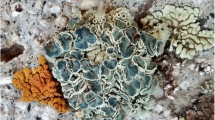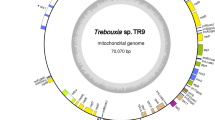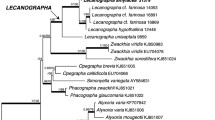Abstract
Evolutionary studies in lichen associations follow that of the fungal symbiont (mycobiont), which is the symbiont after which the lichen is named and forms the majority of the thallus. However, evolution of the algal partner (photobiont) is important to maintain compatibility between symbionts and to optimize productivity of the lichen association. The internal transcribed spacer (ITS) regions of the nuclear ribosomal DNA (rDNA) were examined for primary DNA sequence patterns and for patterns in the secondary structure of the rRNA transcripts in both symbionts of the genus Cladonia. Fungal and algal symbionts show opposite trends in rates of evolution and fragment lengths. Both symbionts showed stronger conservation of the ITS2 structure than the ITS1 structure. Homology was evident in the secondary structures between the two highly divergent chlorophyte and ascomycete taxonomic groups. Most fungal species and all species complexes were polyphyletic. The ITS rDNA of the natural lichen algae from Manitoba and four known algal species is highly similar. The natural lichen algae segregate into highly supported clades by environmental features, suggesting that algae that are already adapted to the environment may associate with germinating fungal propagules in the genus Cladonia. Fungal plasticity may allow the mycobiont to adapt to the environment of the photobiont producing variation in lichen morphology. This might explain the incongruence of phylogenetic patterns between the algal and fungal partners tested and the polyphyly of the fungal species.






Similar content being viewed by others
References
Ahmadjian V (1987) Coevolution in lichens. Ann NY Acad Sci 503:307–315
Ahti T (1980) Taxonomic revision of Cladonia gracilis and its allies. Ann Bot Fenn 17:195–243
Ahti T (2000) Cladoniaceae, Flora Neotropica Monograph 78. New York Botanical Garden, New York
Ahti T, DePriest PT (2001) New combinations of Cladina epithets in Cladonia (Ascomycotina:Cladoniaceae). Mycotaxon 78:499–502
Aptroot A, Sipman HJM, van Herk CM (2001) Cladonia monomorpha, a neglected cup lichen from Europe. Lichenologist 33:271–283
Armaleo D, Clerc P (1991) Lichen chimeras: DNA analysis suggests that one fungus forms two morphotypes. Exp Mycol 15:1–10
Bakker FT, Olsen JL, Stam WT (1995) Evolution of nuclear rDNA ITS sequences in the Cladophora albida/sericea clade (Chlorophyta). J Mol Evol 40:640–651
Beck A (1999) Photobiont inventory of a lichen community growing on heavy-metal-rich rock. Lichenologist 31:501–510
Beck A, Friedl T, Rambold G (1998) Selectivity of photobiont choice in a defined lichen community: inferences from cultural and molecular studies. New Phytol 139:709–720
Brodo IM (1973) Substrate ecology. In Ahmadjian V, Hale ME (eds) The lichens. Academic Press, New York, pp 401–441
Brodo IM, Sharnoff SD, Sharnoff S (2001) Lichens of North America. Yale University Press, London
Coleman AW (2003) ITS2 is a double-edged tool for eukaryote evolutionary comparisons. Trends Genet 19:370–375
Coleman AW, Mai JC (1997) Ribosomal DNA ITS-1 and ITS-2 sequence comparisons as a tool for predicting genetic relatedness. J Mol Evol 45:168–177
Coleman AW, Preparata RM, Mehrotra B, Mai JC (1998) Derivation of the secondary structure of the ITS-1 transcript in Volvocales and its taxonomic correlations. Protist 149:135–146
Côté CA, Greer CL, Peculis BA (2002) Dynamic conformational model for the role of ITS2 in pre-rRNA processing in yeast. RNA 8:786–797
Culberson CF (1972) Improved conditions and new data for the identification of lichen products by a standardized thin-layer chromatographic method. J Chromatogr 72:113–125
Culberson CF (1986) Biogenetic relationships of the lichen substances in the framework of systematics. Bryologist 89:91–98
Culberson CF, Culberson WL, Johnson A (1988) Gene flow in lichens. Am J Bot 75:1135–1139
Culberson WL (1986) Chemistry and sibling speciation in the lichen-forming fungi: ecological and biological considerations. Bryologist 89:123–131
Esslinger TL (2006) A cumulative checklist for the lichen-forming, lichenicolous and allied fungi of the continental United States and Canada. North Dakota State University, Fargo; available at: http://www.ndsu.nodak.edu/instruct/esslinge/chcklst/chcklst7htm; accessed 10 April 2006
Felsenstein J (1985) Confidence limits on phylogenies: an approach using the bootstrap. Evolution 39:783–791
Freidl T (1987) Thallus development and phycobionts of the parasitic lichen Diploschistes muscorum. Lichenologist 19:183–191
Friedl T (1989) Comparative ultrastructure of pyrenoids in Trebouxia (Microthamniales, Chlorophyta). Plant Syst Evol 164:145–159
Friedl T, Rokitta C (1997) Species relationships in the lichen alga Trebouxia (Chlorophyta, Trebouxiophyceae): molecular phylogenetic analyses of nuclear-encoded large subunit rRNA gene sequences. Symbiosis 23:125–148
Friedl T, Zeltner C (1994) Assessing the relationships of some coccoid green lichen algae and the Microthamniales (Chlorophyta) with 18S ribosomal RNA gene sequence comparisons. J Phycol 30:500–506
Gargas A, DePriest PT, Grube M, Tehler A (1995) Multiple origins oflichen symbioses in fungi suggested by SSU rDNA phylogeny. Science 268(5216):1492–1495
Gilbert OL (1977) Fungal plasticity in Cladonia pocillum. Lichenologist 9:172–173
Goffinet B, Bayer RJ (1997) Characterization of mycobionts of photomorph pairs in the Peltigeraceae (lichenized Ascomycetes) based on internal transcribed spacer sequences of the nucler ribosomal DNA. Fungal Genet Biol 21:228–237
Good L, Intine RVA, Nazar RN (1997) Interdependence in the processing of ribosomal RNAs in Schizosaccharomyces pombe. J Mol Biol 273:782–788
Grube M, DePriest PT, Gargas A, Hafellner J (1995) DNA isolation from lichen ascomata. Mycol Res 99:1321–1324
Hausner G, Wang X (2005) Unusual compact rDNA gene arrangements within some members of the Ascomycota: evidence for molecular co-evolution between ITS1 and ITS2. Genome 48:1–13
Hawksworth DL (1973) Ecological factors and species delimitation in the lichens. In: Heywood VH (ed) Taxonomy and ecology. Academic Press, New York, pp 31–70
Helms G, Friedl T, Rambold G, Mayrhofer H (2001) Identification of photobionts from the lichen family Physciaceae using algal-specific ITS rDNA sequencing. Lichenologist 33:73–86
Hildreth KC, Ahmadjian V (1981) A study of Trebouxia and Pseudotrebouxia isolates from different lichens. Lichenologist 13:65–86
Honegger R (1996) Mycobionts. In: Nash TH III, (ed) Lichen biology. Cambridge University Press, New York, pp 24–36
Janzen DH (1980) When is it coevolution? Evolution 34:611–612
Joseph N, Krauskoph E, Vera MI, Michot B (1999) Ribosomal internal transcribed spacer 2 (ITS2) exhibits a common core of secondary structure in vertebrates and yeast. Nucleic Acids Res 27:4533–4540
Kishino H, Hasagawa M (1989) Evaluation of the maximum likelihood estimate of the evolutionary tree topologies from DNA sequence data, and the branching order in Hominoidea. J Mol Evol 29:170–179
Kroken S, Taylor JW (2000) Phylogenetic species, reproductive mode, and specificity of the green alga Trebouxia forming lichens with the fungal genus Letharia. Bryologist 103:645–660
Lalev AI, Nazar RN (1998) Conserved core structure in the internal transcribed spacer 1 of the Schizosaccharomyces pombe precursor ribosomal RNA. J Mol Biol 284:1341–1351
Lalev AI, Abeyrathne PD, Nazar RN (2000) Ribosomal RNA maturation in Schizosaccharomyces pombe is dependent on a large ribonucleoprotein complex of the internal transcribed spacer 1. J Mol Biol 302:65–77
Laundon JR (1995) On the classification of lichen photomorphs. Taxon 44:387–389
Lott TJ, Burns BM, Zancope-Oliveira R, Elie CM, Reiss E (1998) Sequence analysis of the Internal Transcribed Spacer 2 (ITS2) from yeast species within the genus Candida. Curr Microbiol 36:63–69
Lutzoni FM (1997) Phylogeny of lichen- and non-lichen-forming omphalinoid mushrooms and the utility of testing for combinability among multiple data sets. Syst Biol 46:373–406
Lutzoni F, Pagel M, Reeb V (2001) Major fungal lineages are derived from lichen symbiotic ancestors. Nature 411:937–940
Mai JC, Coleman AW (1997) The internal transcribed spacer 2 exhibits a common secondary structure in green algae and flowering plants. J Mol Evol 44:258–271
Mai JC, Myllys L, Lohtander K, Tehler A (2001) Beta-tubulin, ITS and group I intron sequences challenge the species pair concept in Physcia aipolia and P. caesia. Mycologia 93:335–343
Ohmura Y, Kawachi M, Kasai F, Watanabe MM (2006) Genetic combinations of symbionts in a vegetatively reproducing lichen, Parmotrema tinctorum, based on ITS rDNA sequences. Bryologist 109:43–59
Ott S (1987) Sexual reproduction and developmental adaptations in Xanthoria parietina. Nordic J Bot 7:219–228
Ott S, Meier T, Jahns HM (1995) Development, regeneration, and parasitic interactions between the lichens Fulgensia bracteata and Toninia caeruleonigricans. Can J Bot 73 (Suppl 1):S595–S602
Paterson AM, Gray RD (1997) Host-parasite co-speciation, host switching, and missing the boat. In: Clayton DH, Moore J (eds) Host-parasite evolution. Oxford University Press, New York, pp 236–250
Piercey-Normore MD (2004) Selection of algal partners by lichen fungi and patterns of variation for three species of Cladonia. Can J Bot 82:947–961
Piercey-Normore MD (2006) The lichen-forming ascomycete Evernia mesomorpha associates with multiple genotypes of Trebouxia jamesii. New Phytol 169:331–344
Piercey-Normore MD, DePriest PT (2001) Algal switching among lichen symbioses. Am J Bot 88:1490–1498
Piercey-Normore MD, Coxson D, Goward T, Goffinet B. (2006) Phylogenetic position of a Pacific Northwest North American endemic cyanolichen, Nephroma occultum (Ascomycota, Peltigerales). Lichenologist 38:441–456
Pintado A, Valladares F, Sancho LG (1997) Exploring phenotypic plasticity in the lichen Ramalina capitata: morphology, water relations, and chlorophyll content in north- and south-facing populations. Ann Bot 80:345–353
Purvis OW (1997) The species concept in lichens. In: Claridge MF, Dawah HA, Wilson MR (ed) Species: the units of biodiversity. The systematics association special volume series 54. Chapman and Hall, London, pp 109–134
Rambaut A (2001) Se-Al (sequence alignment editor version 1). Department of Zoology, University of Oxford, Oxford, UK
Rikkinen J (1997) Habitat shifts and morphological variation of Pseudevernia furfuracea along a topographical gradient. Symb Bot Ups 32:223–245
Rikkinen J, Oksanen I, Lohtander K (2002) Lichen guilds share related cyanobacterial symbionts. Science 297:357
Sojo F, Valladares F, Sancho LG (1997) Structural and physiological plasticity of the lichen Catillaria corymbosa in different microhabitats of the maritime Antarctica. Bryologist 100:171–179
Stenroos S, Hyvonen J, Myllys L, Thell A, Ahti T (2002) Phylogeny of the genus Cladonia s. lat. (Cladoniaceae, Ascomycetes) inferred from molecular, morphological, and chemical data. Cladistics 18:237–278
Stenroos S, Stocker-Wörgötter E, Yoshimura I, Myllys L, Thell A, Hyvönen J (2003) Culture experiments and DNA sequence data confirm the identity of Lobaria photomorphs. Can J Bot 81:232–247
Swofford DL (2003) PAUP*. Phylogenetic Analysis Using Parsimony (*and other methods), version 4. Sinauer Associates, Sunderland, MA
Thompson JN (1994) The coevolutionary process. University of Chicago Press, Chicago
Thomson JW (1967) The lichen genus Cladonia in North America. University of Toronto Press, Toronto
Thomson JW (1984) American Arctic lichens. 1. The macrolichens. Columbia University Press, New York
Torres RA, Ganal M, Hamleben V (1990) GC balance in the internal transcribed spacers ITS1 and ITS2 of nuclear ribosomal RNA genes. J Mol Evol 30:170–181
Wedin M, Doring H, Gilenstam G (2004) Saprotrophy and lichenization as options for the same fungal species on different substrata: environmental plasticity and fungal lifestyles in the Stictis-Conotrema complex. New Phytol 164:459–465
White TJ, Bruns TD, Lee SB, Taylor JW (1990) Amplification and direct sequencing of fungal ribosomal RNA genes for phylogenetics. In: Innis MA, Gelfand DH, Sninsky JJ, White TJ (eds) PCR protocols: a guide to methods and applications. Academic Press, New York, pp 315–322
Yahr R, Vilgalys R, DePriest PT (2004) Strong fungal specificity and selectivity for algal symbionts in Florida scrub Cladonia lichens. Mol Ecol 13:3367–3378
Zoller S, Lutzoni F (2003) slow algae, fast fungi: exceptionally high nucleotide substitution rate differences between lichenized fungi Omphalina and their symbiotic green algae Coccomyxa. Mol Phylogenet Evol 29:629–640
Zuker M (2003) Mfold web server for nucleic acid folding and hybridization prediction. Nucleic Acids Res 31:3406–3415
Acknowledgments
The authors thank G. Hausner (University of Manitoba) for review of a previous version of the manuscript; G. Robinson (University of Manitoba) for insightful discussions on algal biology; H. Hernandez (Manitoba Conservation) for kind provision of collection permit 17613; and B. Reside, C. Elliot, and M. Manseau (Parks Canada) for financial and technical support and provision of collection permit 2002–04. Part of the study was a M.Sc. project of S.B. The study was funded by a Natural Sciences and Engineering Research Council of Canada (NSERC) grant to M.P-N.
Author information
Authors and Affiliations
Corresponding author
Additional information
[Reviewing Editor: Dr. Debashish Bhattacharya]
Rights and permissions
About this article
Cite this article
Beiggi, S., Piercey-Normore, M.D. Evolution of ITS Ribosomal RNA Secondary Structures in Fungal and Algal Symbionts of Selected Species of Cladonia sect. Cladonia (Cladoniaceae, Ascomycotina). J Mol Evol 64, 528–542 (2007). https://doi.org/10.1007/s00239-006-0115-x
Received:
Accepted:
Published:
Issue Date:
DOI: https://doi.org/10.1007/s00239-006-0115-x




